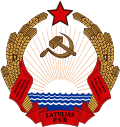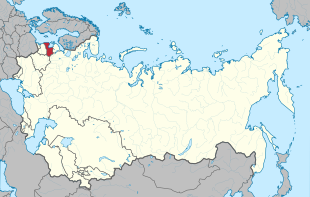Latvian Soviet Socialist Republic
| Latvijas Padomju Sociālistiskā Republika Латвийская Советская Социалистическая Республика |
|||||
| Latvian Soviet Socialist Republic | |||||
|
|||||
| Official language | officially none; de facto Latvian and Russian | ||||
| Capital | Riga | ||||
| surface | 64,589 km² | ||||
| population | 2,666,567 | ||||
| Population density | 41.3 inhabitants per km² | ||||
| National anthem | Anthem of the Latvian SSR | ||||
| Time zone | UTC + 3 | ||||
The Latvian Soviet Socialist Republic (abbreviation LSSR or LATSSR , Latvian: LPSR = Latvijas Padomju Sociālistiskā Republika , literally Latvian Soviet Socialist Republic ) was a union republic of the Union of Soviet Socialist Republics . It existed from the invasion of the Red Army in 1940 until the state independence of the Republic of Latvia was renewed in 1990.
Latvian Soviet Socialist Republic 1918–1920
During the period of the Latvian War of Independence and the Russian Civil War , there was a Latvian Soviet Socialist Republic from December 1918 to January 1920 .
Latvian Soviet Socialist Republic 1940–1990 / 91
In view of the Hitler-Stalin Pact and the German-Soviet division of Poland and its subsequent occupation by the two countries, Latvia was forced, under Soviet pressure, to conclude an assistance pact with the Soviet Union in October 1939 and to permit the stationing of Soviet troops in the country. After the French defeat in 1940, additional Soviet troops marched in on June 17, 1940, while communist strikes and riots broke out across the country. The government agreed to the invasion on June 16, but then resigned, and President Kārlis Ulmanis declared a state of emergency on June 18. On June 20, 1940 Ulmanis appointed the social democratic professor Augusts Kirhenšteins as prime minister and foreign minister, who formed a coalition with the communists on June 23 and for 14/15. July 1940 elections for the parliament (Saeima), which was dissolved in 1934, were scheduled. As a result of the elections, which were not classified as free by the Western powers, President Ulmanis resigned on July 20, 1940 and handed over all official powers to Kirhenšteins. The new Soviet government (elected by allegedly 97.8% of the participants and 94.8% turnout) proclaimed the establishment of the Soviet republic on July 21 (against the protest of the ambassadors of the Western powers) and asked for accession to the USSR on August 5 1940 took place. Ulmanis was arrested on July 22, 1940 and deported to the USSR, where he died in prison in 1942. According to today's Latvian standpoint, this annexation was illegal under international law. 13 later NATO member states (with the exception of the Netherlands ), who de jure did not recognize the annexation of the three Baltic states, took the same position .
During the Second World War, Latvia was occupied by German troops from 1941 to 1944/45 until the gradual reconquest by the Red Army and administratively assigned to the Reichskommissariat Ostland . The former General Oskars Dankers formed a collaborative puppet administration in 1942, while the communist Arturs Sprogis led Latvian partisan units against Latvian SS units . In February 1945 the enclosed German Army Group North formed a puppet republic of Courland, which capitulated on May 9, 1945. Kirhenšteins returned from exile in Moscow and headed the LSSR until 1952/59, the last anti-communist forest brothers were amnestied or destroyed in 1953/57. At the Tehran Conference in 1943, Roosevelt suggested a plebiscite in the Baltic states, but no decision was taken. Latvia's membership of the Soviet Union was no longer questioned by the allies in the agreements on the post-war order (Tehran and Yalta conferences in 1943 and 1945) and when the UN was founded .
Under Soviet rule around 16,000 Jews left Latvia by 1989.
On May 4, 1990, the newly elected Supreme Soviet (or Council) of the LSSR passed a "Declaration on the Restoration of the Independence of the Republic of Latvia", which - like the declarations of independence of Estonia and Lithuania - by Mikhail Gorbachev immediately declared invalid or unconstitutional by decree was declared. After the failure of the attempted coup on August 19, 1991, the Supreme Council of the Republic of Latvia passed a constitutional law on the state status of the Republic of Latvia on August 21. Iceland became the first state to recognize the independence of the Republic of Latvia on August 22; On August 24, Boris Yeltsin signed an analogous decree as President of the Russian Federative Soviet Republic. Only then, on August 27, 1991, did the Federal Republic of Germany, together with other EC states, recognize the sovereignty of Latvia and resume diplomatic relations that had been interrupted in 1940.
First secretaries of the Central Committee of the Latvian Communist Party
- December 21, 1940 – November 1959: Jānis Kalnbērziņš
- November 1959–15. April 1966: Arvīds Pelše
- April 15, 1966-14. April 1984: Augusts Voss
- April 14, 1984-4. October 1988: Boriss Pugo
- October 4, 1988-7. April 1990: Jānis Vagris
- April 7, 1990-24. August 1991: Alfrēds Rubiks
See also
literature
- V. Karaluns, N. Neilands, I. Ronis, A. Spreslis, E. Zagars: Lettland 1917–1940. The choice that was made twice. 1917-1940. Documentary report. Riga 1986; APN-Verl., Moscow 1987, OCLC 246100107 .
Web links
- Ethnic structure of Latvia. In: lettia.lv (English)
Individual evidence
- ↑ See shorthand reports. 8th German Bundestag , Annex 48 to the 184th session, November 9, 1979; P. 14541 (PDF; 3.2 MB; P. 14541 or 61 of 98), accessed on August 9, 2016.
- ^ The Baltic nations - Estonia, Latvia, Lithuania (= nationality and regional problems in Eastern Europe. Vol. 4). 2., ext. Ed. By Boris Meissner , working group for nationality and regional problems in the Soviet Union, East-Central and Southeastern Europe in connection with the German Society for Eastern European Studies and the Southeastern European Society . Markus, Cologne 1991, ISBN 3-87511-041-2 , p. 278.
- ↑ Latvian Occupation Museum (ed.): Latvia under Soviet and National Socialist rule 1940–1991 . Latvijas Okupācijas muzeja biedrība, Riga 1998, p. 163.
- ↑ Latvian Occupation Museum (ed.): Latvia under Soviet and National Socialist rule 1940–1991 . Latvijas Okupācijas muzeja biedrība, Riga 1998, p. 184 f.



